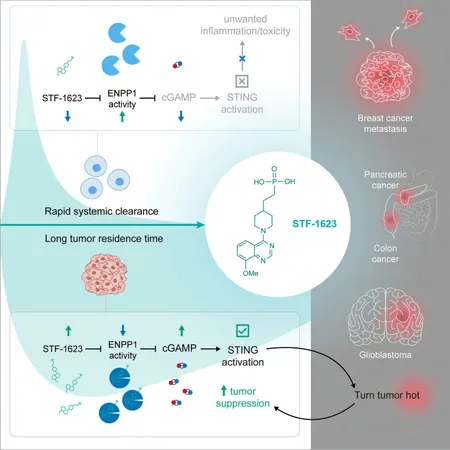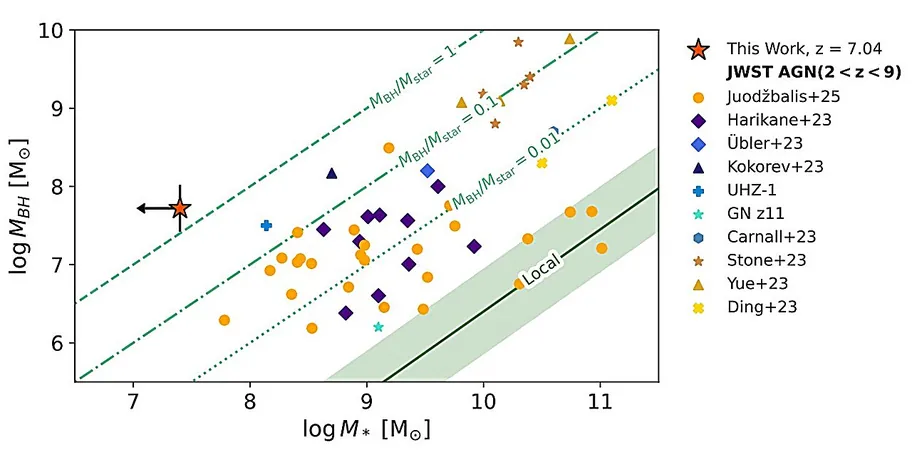
Revolutionary Immunotherapy Drug Sparks Hope for Solid Tumors
2025-09-08
Author: Arjun
Transforming Cold Tumors into Hot Targets
Immunotherapy has long relied on empowering T cells to combat cancer, primarily focusing on types like melanoma and blood cancers. However, solid tumors often present a challenging ‘cold’ environment where the body’s immune responses are subdued, hampering efforts to eliminate these cancers.
Biochemist Lingyin Li is on a groundbreaking mission to change this narrative. Her innovative approach seeks to heat up these ‘cold’ tumor environments, making them receptive to treatment. Rather than amplifying T cells, she has turned her attention to cGAMP, a rapid-response molecule from the innate immune system that acts as the body’s first line of defense against threats.
The Discovery of STF-1623: A Game Changer
Li discovered that tumors can cleverly evade immune detection by producing excess ENPP1 proteins, which dismantle cGAMP before it can rally an immune response. Armed with this insight, she and her team developed STF-1623, a pioneering drug that inhibits ENPP1, allowing cGAMP to signal the immune system effectively.
In a remarkable study published in *Cell Reports Medicine*, Li and her team highlighted how STF-1623 activated the innate immune response to suppress tumors across various mouse models, including breast, pancreatic, colorectal, and glioblastoma cancers. Impressively, no adverse effects were recorded in the test subjects, likely due to the drug’s target-specific mechanism.
A New Dawn for Cancer Treatment
Li’s findings mark a pivotal stride in cancer therapy, representing the first successful targeting of an innate immune checkpoint. "This could be a breakthrough in treating solid tumors that traditional immunotherapies have failed to address," Li stated, emphasizing the study’s potential to reshape cancer treatment.
Since the synthesis of STF-1623 in 2016, Li’s research has steadily unraveled how ENPP1 enables cancer cells to dodge immune responses and shown how to counteract this evasion.
How STF-1623 Works: A Biochemical Ballet
Our immune system, while adept at fighting external threats, also reacts to internal dangers like cancer. When cancer cells become genomically unstable, they release stray DNA that ideally triggers a response. However, ENPP1 disrupts this alarm system, hindering detection.
STF-1623 addresses this by blocking ENPP1, allowing cGAMP to rally around cancer cells and activate immune cells through STING pathways. Once triggered, this sparks a robust immune response, transforming the tumor environment from hostile to hospitable for immune activity.
A Unique Mechanism with Lasting Impact
What sets STF-1623 apart is its ability to bind to ENPP1 for over 24 hours, enhancing its efficacy while minimizing potential side effects. As the researchers mapped the atomic structure of STF-1623 and its interaction with ENPP1, they confirmed a perfect fit that facilitates its prolonged action.
Collaborative Cancer Solutions Ahead
Though STF-1623 shows immense promise, initial results indicate it works best in conjunction with other therapies. "Cancer's complexity means no single treatment is the silver bullet for every patient," Li cautioned. Her goal is to empower the body to combat cancer by activating the innate immune system directly at the tumor site.
Distinct from direct STING agonists, which have yielded mixed results in clinical trials, STF-1623 focuses on amplifying naturally occurring cGAMP within cancer cells. This strategy could lead to a more measured immune response.
Looking to the Future: Clinical Trials on the Horizon
With FDA approval secured to launch clinical trials, Li is enthusiastic about recruiting patients for Phase I soon. The promise that STF-1623 holds signifies not just a potential breakthrough in immunotherapy but a beacon of hope for countless individuals battling solid tumors.



 Brasil (PT)
Brasil (PT)
 Canada (EN)
Canada (EN)
 Chile (ES)
Chile (ES)
 Česko (CS)
Česko (CS)
 대한민국 (KO)
대한민국 (KO)
 España (ES)
España (ES)
 France (FR)
France (FR)
 Hong Kong (EN)
Hong Kong (EN)
 Italia (IT)
Italia (IT)
 日本 (JA)
日本 (JA)
 Magyarország (HU)
Magyarország (HU)
 Norge (NO)
Norge (NO)
 Polska (PL)
Polska (PL)
 Schweiz (DE)
Schweiz (DE)
 Singapore (EN)
Singapore (EN)
 Sverige (SV)
Sverige (SV)
 Suomi (FI)
Suomi (FI)
 Türkiye (TR)
Türkiye (TR)
 الإمارات العربية المتحدة (AR)
الإمارات العربية المتحدة (AR)